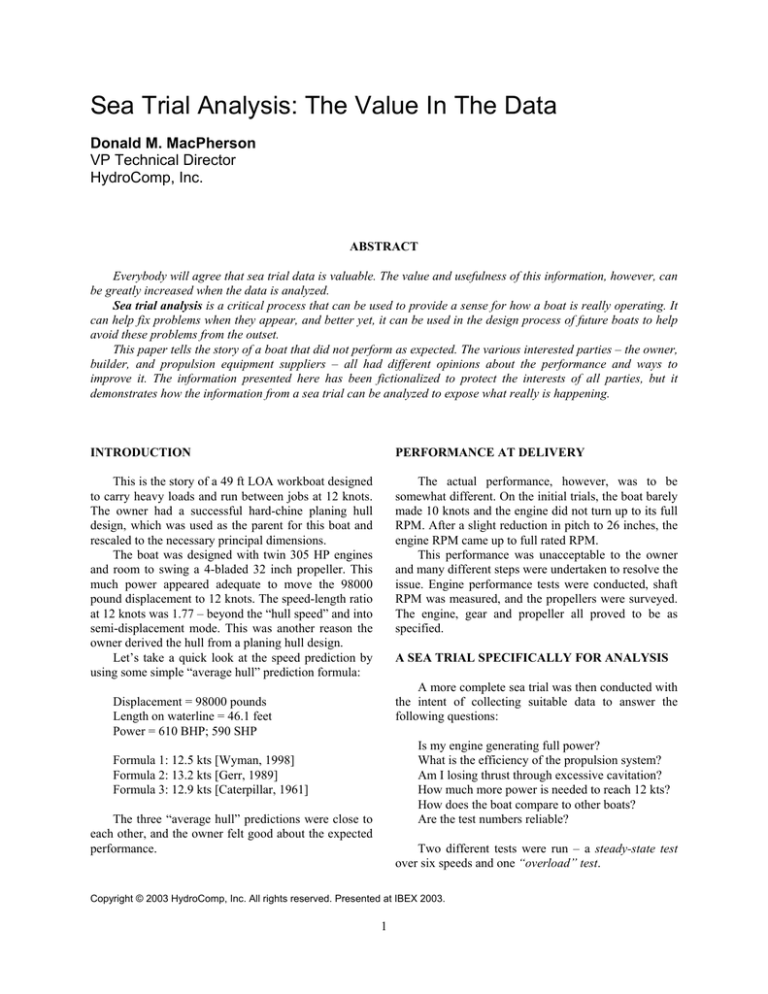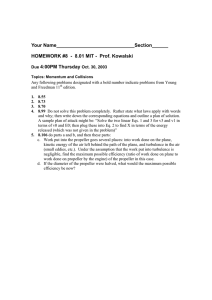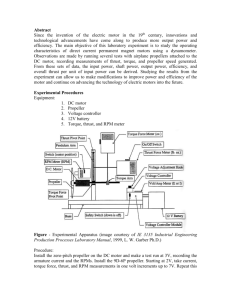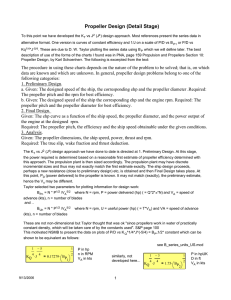
Sea Trial Analysis: The Value In The Data
Donald M. MacPherson
VP Technical Director
HydroComp, Inc.
ABSTRACT
Everybody will agree that sea trial data is valuable. The value and usefulness of this information, however, can
be greatly increased when the data is analyzed.
Sea trial analysis is a critical process that can be used to provide a sense for how a boat is really operating. It
can help fix problems when they appear, and better yet, it can be used in the design process of future boats to help
avoid these problems from the outset.
This paper tells the story of a boat that did not perform as expected. The various interested parties – the owner,
builder, and propulsion equipment suppliers – all had different opinions about the performance and ways to
improve it. The information presented here has been fictionalized to protect the interests of all parties, but it
demonstrates how the information from a sea trial can be analyzed to expose what really is happening.
INTRODUCTION
PERFORMANCE AT DELIVERY
This is the story of a 49 ft LOA workboat designed
to carry heavy loads and run between jobs at 12 knots.
The owner had a successful hard-chine planing hull
design, which was used as the parent for this boat and
rescaled to the necessary principal dimensions.
The boat was designed with twin 305 HP engines
and room to swing a 4-bladed 32 inch propeller. This
much power appeared adequate to move the 98000
pound displacement to 12 knots. The speed-length ratio
at 12 knots was 1.77 – beyond the “hull speed” and into
semi-displacement mode. This was another reason the
owner derived the hull from a planing hull design.
Let’s take a quick look at the speed prediction by
using some simple “average hull” prediction formula:
The actual performance, however, was to be
somewhat different. On the initial trials, the boat barely
made 10 knots and the engine did not turn up to its full
RPM. After a slight reduction in pitch to 26 inches, the
engine RPM came up to full rated RPM.
This performance was unacceptable to the owner
and many different steps were undertaken to resolve the
issue. Engine performance tests were conducted, shaft
RPM was measured, and the propellers were surveyed.
The engine, gear and propeller all proved to be as
specified.
A SEA TRIAL SPECIFICALLY FOR ANALYSIS
A more complete sea trial was then conducted with
the intent of collecting suitable data to answer the
following questions:
Displacement = 98000 pounds
Length on waterline = 46.1 feet
Power = 610 BHP; 590 SHP
Is my engine generating full power?
What is the efficiency of the propulsion system?
Am I losing thrust through excessive cavitation?
How much more power is needed to reach 12 kts?
How does the boat compare to other boats?
Are the test numbers reliable?
Formula 1: 12.5 kts [Wyman, 1998]
Formula 2: 13.2 kts [Gerr, 1989]
Formula 3: 12.9 kts [Caterpillar, 1961]
The three “average hull” predictions were close to
each other, and the owner felt good about the expected
performance.
Two different tests were run – a steady-state test
over six speeds and one “overload” test.
Copyright © 2003 HydroComp, Inc. All rights reserved. Presented at IBEX 2003.
1
TEST CONDITIONS AND MEASUREMENTS
STEADY-STATE TEST AND ANALYSIS
The conditions for the tests were ideal – calm wind
and flat seas in brackish water of 60 feet depth.
Speed was calculated with measured time across a
run of a known distance. Vessel trim was estimated
with a bubble inclinometer, and fuel rate was available
through the engine’s digital readout.
There was nothing about the test condition or
measurements that would corrupt the test results.
Two runs were made for each of six pre-set
tachometer settings from 600 to 2100 RPM. The runs
were made in opposite directions to account for wind
and current. Averaged values were:
RPM
600
900
1200
1500
1800
2100
A COMMENT ON ANALYSIS PROCEDURES
The analysis uses the prediction of propeller thrust
and torque as a “numerical dynamometer”. Principally,
we are looking to define the hull-propulsor-engine
equilibrium (see Figure 1 below).
Thrust
Propulsor
Drag
Wake fraction, etc.
Thrust
Power
Fuel [gph]
0.4
0.8
1.8
4.6
9.2
17.2
Trim [deg]
1.0 [bow]
0.3 [bow]
0.0
0.1
0.9
2.4
This information was entered into the sea trial
analysis software, analysis parameters were defined,
and steady-state results were generated. These results
answered the questions initially posed.
Power
Hull
Speed [kt]
3.71
5.65
7.02
8.38
9.68
10.55
Engine
Is my engine generating full power?
Power/RPM/Fuel
The power predicted for the propeller at each speed
is used to find the corresponding engine brake power
by adding shafting and gear losses. Typical shafting
loses are 2% to 3%, and gear losses 3% to 4%.
A good way to answer this question is with an
Engine-propeller power plot (see Figure 2).
Figure 1. The hull-propulsor-engine equilibrium
Using a variety of prediction techniques and
software tools, we can predict the propeller’s thrust and
required power for a given boat speed and shaft RPM.
Propeller thrust and power can then be used to
determine the derivative performance indicators, such
as efficiency and cavitation.
For further details on the methodology of this
analysis procedure, please refer to any of the numerous
references available on this topic [MacPherson, 2001]
[MacPherson, 1995].
(The example analysis plots shown here were
prepared by HydroComp’s SwiftTrial software. The
supporting reports are in the Appendix.)
400
PB/Prop [hp]
300
200
Engine
100
Accuracy
0
500
It is important to point out that an analysis like this
is never 100% accurate. There are estimates and
predictions used in the analysis, as well as potential
sources of measurement error. Given good
measurement data and an accurate definition of the
propeller (particularly pitch and cup), the accuracy
should be well within 10%, in most cases within 5%.
Fortunately, the purpose of these analyses is to find
indicators and trends, so this small inaccuracy is
acceptable.
A sense for the accuracy of the analysis can be
found with the “overload” test described later.
1000
1500
2000
2500
EngRPM [RPM]
Figure 2. Engine-propeller power
From this plot, you see power and RPM for each
speed, as well as the engine’s performance curve. We
can determine from this plot that there is a good match
between the engine and the propeller. In other words,
the propeller is using all of the power the engine has to
offer and the engine is operating to its full potential.
2
We can see that cavitation is very light up to about
10 knots, where it begins to climb. Even at the highest
speed, however, the cavitation is acceptable and far
from thrust breakdown.
What is the efficiency of the propulsion system?
Part of the basic propeller performance analysis is
to determine the propeller efficiency, which is shown in
the plot below (Figure 3).
10
0.58
9
8
0.56
7
Cav(%)
PropEff
0.54
0.52
6
5
4
0.50
3
2
0.48
1
0.46
3
4
5
6
7
8
9
10
3
4
5
6
7
8
9
10
11
10
11
Speed [kts]
11
Speed [kts]
Figure 4. Cavitation percentage
Figure 3. Propeller efficiency
130
The maximum efficiency occurs between five and
six knots. If we could get 56% efficiency at top speed,
we’d be able to generate about 15% more thrust. So,
why not optimize the propeller for top speed? What can
we do?
The natural tendency to optimize for a higher
speed is to increase pitch. Look back at the Enginepropeller power plot. This propeller is using all of the
power available to it. An increase in pitch will require
more power than the engine has to offer.
There is one solution – slow down the propeller.
Change the reduction ratio to allow a larger pitch
without an increase in power. So, we can conclude that
our propeller could be better, but first we need a change
in reduction ratio.
120
110
TipSpeed [ft/s]
100
•
70
50
40
30
3
4
5
6
7
8
9
Speed [kts]
Figure 5. Propeller tip speed
Another cavitation parameter is tip speed (shown
in Figure 5). Tip speeds below 175 ft/s for open
propellers (150 ft/s for 5-bladed propellers) is
considered acceptable. These propellers are well within
the limit.
We can state with confidence that cavitation is not
a problem.
The extent of cavitation is principally a function of
propeller thrust and available blade area. A widely-used
cavitation criteria (the Burrill chart) can tell us the
percentage of blade cavitation. We can compare our
results (see Figure 4 below) to three basic levels:
•
80
60
Am I losing thrust through excessive cavitation?
•
90
Less than 5% is considered very light
cavitation.
Less than 15% is considered acceptable for
most commercial applications.
More than 30% cavitation indicates a likely
breakdown in thrust causing “overspin”.
How much more power is needed to reach 12 knots?
This is a difficult question to answer, as it requires
us to forecast a power based on extrapolating the
existing power. A plot of power versus speed will help
here (see Figure 6).
3
400
PB/Prop [hp]
300
200
100
0
3
4
5
6
7
8
9
10
11
Speed [kts]
Figure 6. Speed versus power
If we simply extend the plot in a straight line, it
would take engines of 600 HP – double the power – to
reach 12 knots. Of course, this prediction is based on
the same propeller efficiency and no changes to the
hull.
How does the boat compare to other boats?
Figure 8. Contemporary limits of transport efficiency
The answer to this can be quite revealing – but
how do we go about comparing boats of different size,
power and speed. We will use a simple merit
relationship called transport efficiency as an indicator.
Transport efficiency (also called transport effectiveness
or specific power) simply relates power to weight and
speed.
These figures show transport efficiency versus
“volumetric Froude number” – a non-dimensional way
to relate speed and weight. We have taken the data for
the “best” contemporary transport efficiency for hardchine hulls and created the plot below (Figure 9) for the
speed range of interest. This plot shows percentages of
the “best” figure, as well as where the tested boat lies.
100
90
80
TranspEff
70
60
50
40
30
20
10
0
3
4
5
6
7
8
9
10
11
Speed [kts]
Figure 7. Transport efficiency
Figure 9. Normalized transport efficiency
Now that we have these numbers, what do they
mean? For this, we will refer to a plot of contemporary
“best” values of transport efficiency [Blount, 1994].
The original plot was in a logarithmic scale, so the
data was modified to divide the transport efficiency by
the cube of the volumetric Froude number to make the
4
curves flatter and easier to read. We can clearly see that
this boat is far from being the “best-of-all-possibleboats”. Its transport efficiency is highest at 5-6 knots,
which corresponds to the highest propeller efficiency,
but even so, it is only 40% as efficient as the “best”
boats. At top speed it is even worse.
CONCLUSIONS
Much of the valuable information to be found in a
sea trial is hidden. You must analyze the numbers to
see what is really happening.
Analysis is not complicated and can be performed
with your own calculations or commercial software. Let
us review what the analysis found for this vessel.
OVERLOAD TEST AND ANALYSIS
An overload test is where a twin-screw boat is run
at “wide open throttle” (WOT) using one side only. For
example, you shut down and unclutch the starboard
engine, then run the boat using the port engine only.
This test allows you to confirm two things – that the
calculation of propeller performance is reasonable, and
that the predicted power at a lower speed is correct.
Running with the port engine only, the boat made
8.8 knots and the engine ran up to 2010 RPM. Fuel rate
was 16.8 gal/hr. Using this speed and RPM, the
overload point can be plotted onto the engine curve
(see Figure 10).
Is my engine generating full power?
The propeller is using all of the power the engine
has to offer and the engine is operating to its full
potential.
What is the efficiency of the propulsion system?
The propeller is operating at its highest efficiency
at between 5 and 6 knots. Higher efficiency is
possible at higher speeds, but it will require a
change in reduction ratio.
Am I losing thrust through excessive cavitation?
400
PB/Prop [hp]
300
We can state with confidence that cavitation is not
a problem.
PORT
How much more power is needed to reach 12 knots?
200
Based on a simple extrapolation of power, it would
take double the power to increase speed from 10.6
to 12 knots. This forecast is based on the same
propeller efficiency and no changes to the hull.
Engine
100
0
0STBD
500
1000
1500
2000
How does the boat compare to other boats?
2500
EngRPM [RPM]
This boat is far from being an efficient vehicle. It is
best at 5-6 knots, which corresponds to the highest
propeller efficiency, but even so, it is only 40% as
efficient as the “best” boats. At top speed it is even
worse.
Figure 10. Overload test point
Our objective is to overload the system so that
equilibrium occurs below rated RPM. Using an engine
builder’s published performance information about our
engine model, we know precisely what the power
should be for a particular RPM. This leads us to the
answer to the final question.
Are the test numbers reliable?
We have good confirmation that all of the data is
reliable.
Are the test numbers reliable?
Collecting sea trial data is only half of the job –
you cannot know how a boat is actually performing
without analyzing the data in the manner described
here.
So what happened with the boat? It was eventually
repowered and provided with a new gear and propeller.
Performance improved – most notably as a sizable
reduction in fuel consumption using the higher
When an overload point lies on the engine power
curve, as is the case here, we have good confirmation
that all of the data is reliable.
5
efficiency gear ratio and propeller. The greatest lesson,
however, may have been that deriving the hull from a
hard-chine, deep-transom planing boat was not a good
decision.
APPENDIX
Attached at the end of this paper are the sea trial
analysis reports for this example.
REFERENCES
Blount, D.L., "Achievements with Advanced Craft",
Naval Engineers Journal, Sep 1994.
Caterpillar, “Hull Speed Estimator” slide rule, 1961.
Gerr, D., Propeller Handbook, International Marine
Publishing Company, 1989.
MacPherson, D.M., “Analyzing and Troubleshooting
Poor Vessel Performance”, 11th Fast Ferry
International Conference, Hong Kong, Feb 1995.
MacPherson, D.M., "The Practical Analysis of Sea
Trial Data", IBEX 2001, Ft. Lauderdale, 2001.
Wyman, D.B., “Wyman’s Formula”, Professional
Boatbuilder, Aug/Sep 1998.
CONTACT
Donald M. MacPherson
VP Technical Director
HydroComp, Inc.
13 Jenkins Court, Suite 200
Durham, NH 03824 USA
Tel (603)868-3344
Fax (603)868-3366
dm@hydrocompinc.com
www.hydrocompinc.com
6
"SwiftTrial Report"
Page 1 of 4
Project
17-Jan-2003
Vessel name: Sample
Ref. number: 0001
Project data
Vessel name
Ref. number
Personnel
Comments
Trial location
Sample
Trial date
0001
Staff
Sample sea trial for analysis.
Durham, NH
January 1, 2003
Trial environment
Water depth
Water type
Water temperature
Sea state
60 ft
Brackish
58 °F
1 [0.5 to 1.5 ft]
Wind speed
Wind direction
Air temperature
0 kts
0 deg
65 °F
Data for test
Draft at bow
Notes
Draft at stern
3.9 ft
Full load condition, slight trim by stern.
4.3 ft
Data for evaluation
Length on WL
Max beam on WL
Max chine beam
Max molded draft
46.1 ft
15.4 ft
15 ft
4.1 ft
Displacement bare
Chine type
Max area coef [Cx]
Wetted surface
98000 lb
Hard
0.67
699.5 ft2
General data
Number of propellers
2
Shaft angle to BL
12 deg
Engine
Engine model
Rated brake power
Sample engine
305 hp
Rated RPM
Fuel rate at rated
2100 RPM
17.2 gal/hr
Gear
Gear model
Gear efficiency
Sample gear
0.965
Gear ratio
2.44
Propeller
Propeller model
Propeller series
Number of blades
Thrust factor
Power factor
Sample propeller
Gawn AEW
4
1
1.03
BAR (exp)
Diameter
Pitch
Cup (TE drop)
Immersion below WL
0.81
32 in
26 in
0 in
4.1 ft
Vessel
Propulsion
This evaluation has been carefully prepared to meet professional standards. Since it is not possible to determine the accuracy of the provided
data, the preparer of this report assumes no liability nor makes any performance guarantees of any kind.
Report ID20030117-1457
HydroComp SwiftTrial 1.01.0004.426
"SwiftTrial Report"
Page 2 of 4
Steady-state trial
17-Jan-2003
Vessel name: Sample
Ref. number: 0001
Trial data [in Brackish water]
Direction 1
Speed
[kts]
3.69
5.66
7.06
8.31
9.52
10.56
Trim
[deg]
-1
-0.25
0
0.1
0.9
2.4
RPM [P]
[RPM]
600
900
1200
1500
1800
2100
RPM [S]
[RPM]
600
900
1200
1500
1800
2100
Fuel [P]
[gal/hr]
0.4
0.8
1.8
4.6
9.2
17.2
Fuel [S]
[gal/hr]
0.4
0.8
1.8
4.6
9.2
17.2
Heading
[deg]
0
0
0
0
0
0
Direction 2
Speed
[kts]
3.72
5.63
6.98
8.45
9.84
10.53
Trim
[deg]
-1
-0.25
0
0.1
0.9
2.4
RPM [P]
[RPM]
600
900
1200
1500
1800
2100
RPM [S]
[RPM]
600
900
1200
1500
1800
2100
Fuel [P]
[gal/hr]
0.4
0.8
1.8
4.6
9.2
17.2
Fuel [S]
[gal/hr]
0.4
0.8
1.8
4.6
9.2
17.2
Heading
[deg]
180
180
180
180
180
180
Averaged values
Speed
Trim
[kts]
[deg]
3.705
-1
5.645
-0.25
7.02
0
8.38
0.1
9.68
0.9
10.55
2.4
RPM [P]
[RPM]
600
900
1200
1500
1800
2100
RPM [S]
[RPM]
600
900
1200
1500
1800
2100
Fuel [P]
[gal/hr]
0.4
0.8
1.8
4.6
9.2
17.2
Fuel [S]
[gal/hr]
0.4
0.8
1.8
4.6
9.2
17.2
Comment
This evaluation has been carefully prepared to meet professional standards. Since it is not possible to determine the accuracy of the provided
data, the preparer of this report assumes no liability nor makes any performance guarantees of any kind.
Report ID20030117-1457
HydroComp SwiftTrial 1.01.0004.426
"SwiftTrial Report"
Page 3 of 4
Analysis
17-Jan-2003
Propulsive coef prediction
Method: Holtrop 1984
Speed: Check
Tunnel stern corr
Off
Hull: Check
Vessel name: Sample
Ref. number: 0001
Details: OK
Analysis results [in Brackish water]
Avg Speed
[kts]
3.705
5.645
7.02
8.38
9.68
10.55
Avg Speed
[kts]
3.705
5.645
7.02
8.38
9.68
10.55
1.0206
1.0206
1.0206
1.0206
1.0206
1.0206
EngineRPM
[RPM]
600.0
900.0
1200.0
1500.0
1800.0
2100.0
T/Prop
[lbf]
334
735
1422
2332
3483
5027
TipSpeed
[ft/s]
34.3
51.5
68.7
85.8
103.0
120.2
Cav
[%]
2.9
2.3
1.7
2.2
4.3
9.8
Rtotal
[lbf]
594
1309
2531
4151
6200
8949
Fv
WakeFr
ThrDed
RelRot
0.324
0.494
0.614
0.733
0.847
0.923
0.1141
0.1126
0.1119
0.1113
0.1109
0.1106
0.1099
0.1099
0.1099
0.1099
0.1099
0.1099
PropEff
TranspEff
Slip
0.5502
0.5632
0.5382
0.5213
0.5070
0.4797
91.2150
42.3076
20.8910
12.3295
8.0243
5.2582
0.296
0.285
0.333
0.363
0.387
0.427
PB/Prop
[hp]
6.3
20.8
52.4
105.9
188.0
312.6
Rtotal/W
0.006
0.013
0.026
0.042
0.063
0.091
This evaluation has been carefully prepared to meet professional standards. Since it is not possible to determine the accuracy of the provided
data, the preparer of this report assumes no liability nor makes any performance guarantees of any kind.
Report ID20030117-1457
HydroComp SwiftTrial 1.01.0004.426
"SwiftTrial Report"
Page 4 of 4
Supplemental trials
17-Jan-2003
Vessel name: Sample
Ref. number: 0001
Overload data
Port data
Engine RPM
Speed
Direction
Comments
2010 RPM
8.8 kts
0 deg
Trim angle
Fuel rate
0 deg
16.8 gal/hr
Starboard data
Engine RPM
Speed
Direction
Comments
0 RPM
0 kts
0 deg
Trim angle
Fuel rate
0 deg
0 gal/hr
Acceleration data
Direction 1
Idle to speed
[kts]
Time to speed
[sec]
Averaged values
Idle to speed
Time to speed
[kts]
[sec]
Heading
[deg]
Direction 2
Idle to speed
[kts]
Time to speed
[sec]
Heading
[deg]
Comments
This evaluation has been carefully prepared to meet professional standards. Since it is not possible to determine the accuracy of the provided
data, the preparer of this report assumes no liability nor makes any performance guarantees of any kind.
Report ID20030117-1457
HydroComp SwiftTrial 1.01.0004.426





